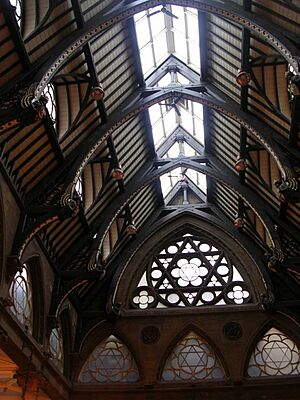Wool Exchange, Bradford facts for kids
The Wool Exchange Building in Bradford, West Yorkshire, England is a very old and important building. It was built in the 1800s as a place where people traded wool. The building looks grand and fancy, showing how important and wealthy Bradford became because of the wool trade. Today, it's a popular Waterstones bookshop and also has a cafe.
How the Wool Exchange Was Designed
The Wool Exchange was built between 1864 and 1867. Designing this building was a big deal in Bradford. A famous art critic named John Ruskin was even asked for his advice. Ruskin believed that truly good buildings came from a kind and caring society. He felt the Exchange, built for business, didn't represent that.
There was a competition to choose the best design. Many architects entered, including Norman Shaw. But a local team, Lockwood and Mawson, won the competition. The first stone of the building was laid by the Prime Minister at the time, Lord Palmerston.
The building's style is called Venetian Gothic, which means it looks like old buildings from Venice, Italy. It also has some influences from Flemish (Belgian) architecture, especially in its tall tower. Ruskin wasn't happy with this style because he felt it copied the look of old buildings without having the same spirit.
When the building was officially recognized as a special historic place in 1963, its main hall was described as having a beautiful, high ceiling with fancy ironwork. The hall also has tall, shiny granite columns with detailed carvings of leaves and plants. There's a lovely balcony and staircase with decorative ironwork too. These carvings were made by artists named Mawer and Ingle from Leeds.
How Wool Was Traded Here
Trading wool at the Exchange was done by just talking and agreeing! People would make a deal verbally, and then each person would write down the price, how much wool was sold, and when it would be delivered.
Only members who had special tickets were allowed on the main trading floor. These tickets were usually given by the companies they worked for. However, there was a walkway around the floor where other salespeople could wait. They would try to get a member's attention to make a deal "off floor."
If you made a deal "off floor," you had to trust that the wool would be good quality. But for deals made "on floor," the wool had to go through a special "conditioning house." Here, experts checked the wool's quality, like its length, and its dry weight. This was important because some people would try to cheat by adding water to the wool to make it heavier! Being a member and having a ticket to trade "on floor" was a sign of high social standing in old Bradford.
The Wool Exchange Today
People stopped trading wool in this building in the early 1970s. Now, the main floor is used by Waterstones to sell books. You can get the best views of the inside from the coffee shop on the mezzanine floor (a floor between two main floors). This part of the building has modern glass windows that let in lots of natural light, which was not common when it was a busy wool trading hall.
For many years, a coffee chain called Starbucks was on the mezzanine floor. But in 2013, Waterstones opened its own coffee shop, 'Café W', in that spot.
Besides Waterstones and Café W, the building also has a newsagent, a pizza restaurant, a panini shop, an employment agency, and a pub called the Exchange Ale House. Outside the building, you can see sculptures of important people from the textile industry, like Joseph Marie Jacquard, who invented a special loom. There are also statues of explorers and politicians. Inside, there's a large statue of Richard Cobden, who was a big supporter of Free Trade (meaning trade without taxes or limits). Cobden was a Member of Parliament for the West Riding of Yorkshire twice. His statue was given by an American businessman named George Henry Booth, who had business in Bradford.
The Wool Exchange stands across from Arndale House. Arndale House was built where the old Victorian Swan Arcade used to be. The Swan Arcade was where the famous writer J. B. Priestley worked, but it was sadly torn down in 1962.




